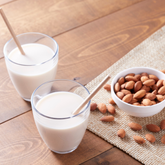As the US Institute for Agriculture and Trade Policy reports, the meat and dairy industry is on track to becoming the single largest contributor to climate change, outpacing even the fossil fuel industry. Dairy practices emit vast quantities of greenhouse gases, and the release of such gases is a leading cause of global warming. Due to the ever-increasing demand for dairy products, the sector’s greenhouse gas emissions increased by more than 18% between 2005 and 2015. Whilst a 2020 IATP report found that the total greenhouse gas emissions of the world’s 13 largest dairy companies supersede that of the entire United Kingdom.
Climate-altering gases such as nitrous oxide, carbon dioxide and critically, methane, are by-products of dairy farming with each gas being released at a different stage of the production system. Methane is released naturally by cows through a process known as enteric fermentation, nitrous oxide is generated by manure storage and management and CO2 is produced during manufacturing and transporting. Methane, which contributes over 45% of the total greenhouse gases emissions released by a dairy farm, is particularly problematic.
Due to its chemical composition methane is remarkably effective at trapping heat: over a 20-year period methane’s global warming potential is more than 80 times that of CO2. Whilst methane is produced by a variety of natural sources, scientists predict that a staggering 50-65% of total methane emissions are anthropogenic or human-influenced, of which 27% is attributed to livestock farming. Unlike CO2, which remains in the atmosphere for thousands of years, methane has a relatively short lifespan breaking down after just 12 years. However as human-influenced emissions rise, the concentration of methane in our atmosphere increases edging us ever closer to the 2°C tipping point.
Today’s accelerating rate of global warming threatens societies around the world by increasing our susceptibility to wildfires, rising sea levels and extreme weather conditions. The number of climate-related disasters have tripled over the last 30 years and, according to the World Meteorological Organization, the period between 2010 and 2019 was the warmest ever recorded. Despite the irrefutable evidence of the industry’s contribution to climate change, dairy companies are not required by law to report their greenhouse gas emissions. It is clear that action must be taken to improve research, policy and regulation surrounding the dairy industry particularly as we work towards mitigating climate change and transitioning to a low-carbon economy.
BIBLIOGRAPHY
IATP & GRAIN, 2018. Emissions Impossible: How big meat and dairy are heating up the planet. [Online] Available at: https://www.iatp.org/sites/default/files/2018-08/Emissions%20impossible%20EN%2012.pdf [Accessed 27 September 2021].
United Nations Economic Commission for Europe, 2021. Methane Management: The Challenge. [Online] Available at: https://unece.org/challenge [Accessed 27 September 2021].
Food and Agriculture Organization of the United Nations, 2019. Climate change and the global dairy cattle sector. [online] Available at: http://www.fao.org/3/CA2929EN/ca2929en.pdf [Accessed 28 September 2021].
United States Environmental Protection Agency, 2021. Overview of Greenhouse Gases. [online] Available at: https://www.epa.gov/ghgemissions/overview-greenhouse-gases [Accessed 28 September 2021].
National Geographic Environment, 2019. Methane, explained. [online] Available at: https://www.nationalgeographic.com/environment/article/methane [Accessed 28 September 2021].
Sharma, S., 2021. Milking the Planet: How Big Dairy is heating up the planet and hollowing rural communities. [online] IATP. Available at: https://www.iatp.org/milking-planet [Accessed 28 September 2021].
World Meteorological Organization. 2019. WMO Provisional Statement on the State of the Global Climate in 2019. [online] Available at: https://public.wmo.int/en/media/press-release/2019-concludes-decade-of-exceptional-global-heat-and-high-impact-weather [Accessed 28 September 2021].
Rotz, C., 2018. Modelling greenhouse gas emissions from dairy farms. Journal of Dairy Science, 101(7), pp.6675-6690.















